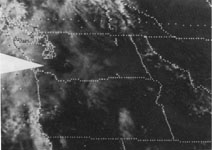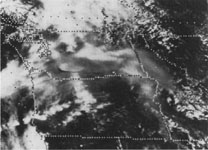

A strong, vertically directed explosion of ash and steam began very shortly after the lateral blast. The resulting eruptive column rose very quickly. In less than 10 minutes, the ash column reached an altitude of more than 12 miles and began to expand into a characteristic mushroom-shaped ash cloud. Near the volcano, the swirling ash particles in the atmosphere generated lightning, which in turn started many forest fires. As the eruption roared on, the major part of the ash cloud drifted downwind in an east-northeasterly direction, although ash that rose above the high-speed (jet-stream) winds followed other paths determined by complex wind directions.
The early form of the May 18 eruption plume, which was
not photographed, probably resembled the mushroom-shaped ash cloud of the
July 22, 1980, eruption shown here (Photograph by James Vallence).
Clear skies permitted tracking the advance of the drifting cloud by satellite imagery. Moving at an average speed of about 60 miles an hour, the cloud reached Yakima, Washington, by 9:45 a.m. PDT and Spokane, Washington, by 11:45 a.m. The ash cloud was dense enough to screen out nearly all sunlight, activating darkness-sensitive switches on street lights in Yakima and Spokane. Street lights remained on for the rest of the darkened day, as the eruption continued vigorously for more than 9 hours, pumping ash into the atmosphere and feeding the drifting ash cloud.
The eruptive column fluctuated in height through the day, but the eruption subsided by late afternoon on May 18. By early May 19, the eruption had stopped. By that time, the ash cloud had spread to the central United States. Two days later, even though the ash cloud had become more diffuse, fine ash was detected by systems used to monitor air pollution in several cities of the northeastern United States. Some of the ash drifted around the globe within about 2 weeks. After circling many more times, most of the ash settled to the Earth's surface, but some of the smallest fragments and aerosols are likely to remain suspended in the upper atmosphere for years.


Weather-satellite imagery (courtesy of NOAA) tracked the movement of the eruption plume: left (0845 PDT)--the expanding plume shortly after the beginning of the May 18 eruption; right (1215 PDT)--the plume had reached Idaho, and a new pulse of ash can be seen at the volcano.

The generalized map shows the distribution of ash fallout from the May 18 eruption.
Prevailing winds distributed the fallout from the ash cloud over a wide region. Light ash falls were reported in most of the Rocky Mountain States, including northern New Mexico, and fine ash dusted a few scattered areas farther east and northeast of the main path. The heaviest ash deposition occurred in a 60-mile-long swath immediately downwind of the volcano. Another area of thick ash deposition, however, occurred near Ritzville in eastern Washington, about 195 miles from Mount St. Helens, where nearly 2 inches of ash blanketed the ground, more than twice as much as at Yakima, which is only about half as far from the volcano. Scientists believe that this unexpected variation in ash thickness may reflect differences in wind velocity and direction with altitude, fluctuations in the height of the ash column during the 9 hours of activity, and the effect of localized clumping of fine ash particles leading to preferential fallout of the large particle clumps.

 (Left) The advancing ash cloud from Mount St. Helens, as seen from the ground
in eastern Washington.
(Left) The advancing ash cloud from Mount St. Helens, as seen from the ground
in eastern Washington.
(Right) Eastern Washington resident sweeping the ash from the roof of his house (Photograph by Kurt Smith).
During the 9 hours of vigorous eruptive activity, about 540 million tons of ash fell over an area of more than 22,000 square miles. The total volume of the ash before its compaction by rainfall was about 0.3 cubic mile, equivalent to an area the size of a football field piled about 150 miles high with fluffy ash. The volume of the uncompacted ash is equivalent to about 0.05 cubic mile of solid rock, or only about 7 percent of the amount of material that slid off in the debris avalanche. The eruption of ash also further enlarged the depression formed initially by the debris avalanche and lateral blast, and helped to create a great amphitheater-shaped crater open to the north. This new crater was about 1 mile by 2 miles wide and about 2,100 feet deep from its rim to its lowest point. The area of this crater roughly encompassed that of the former bulge on the north flank of the volcano and the former summit dome. After the eruption, the highest point on the volcano was about 8,364 feet, or 1,313 feet lower than the former summit elevation.
URL: <https://pubs.usgs.gov/gip/msh/ash.html>
Contact: John Watson
Last updated: 06.25.97